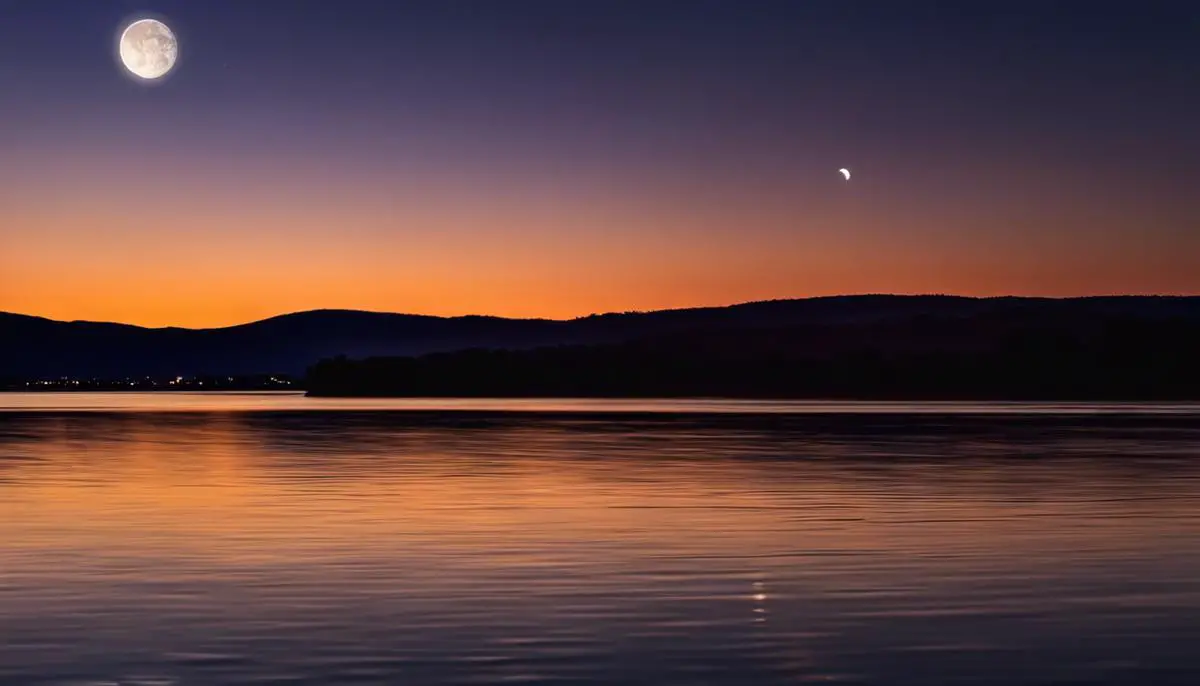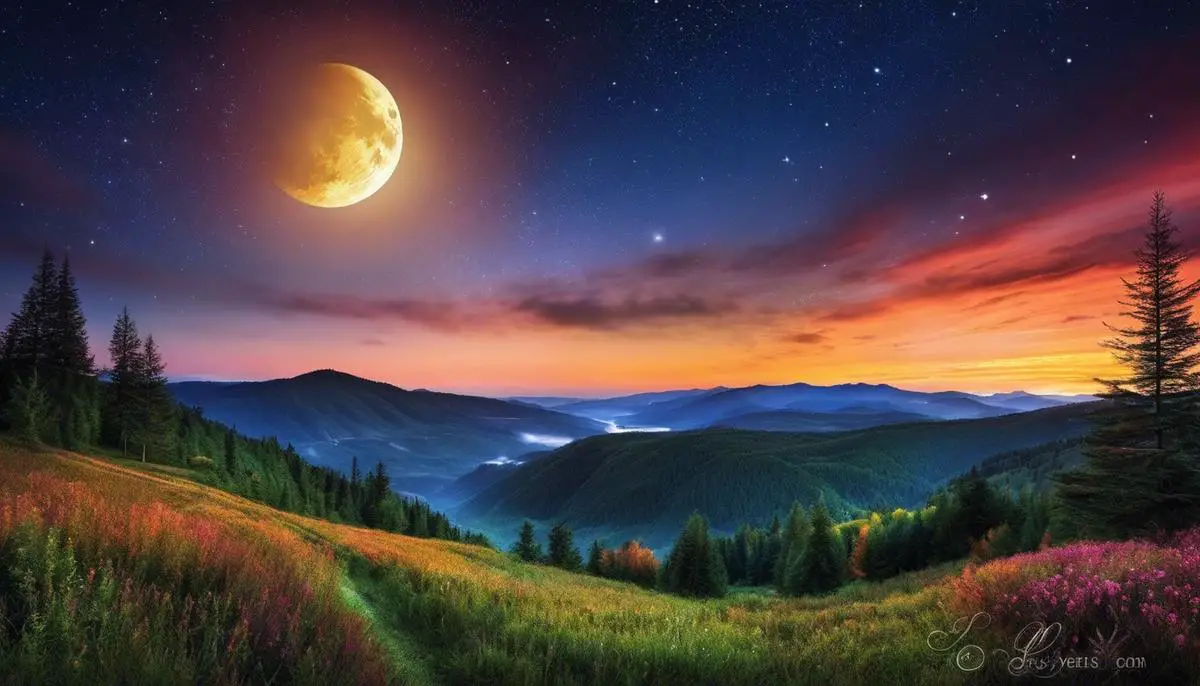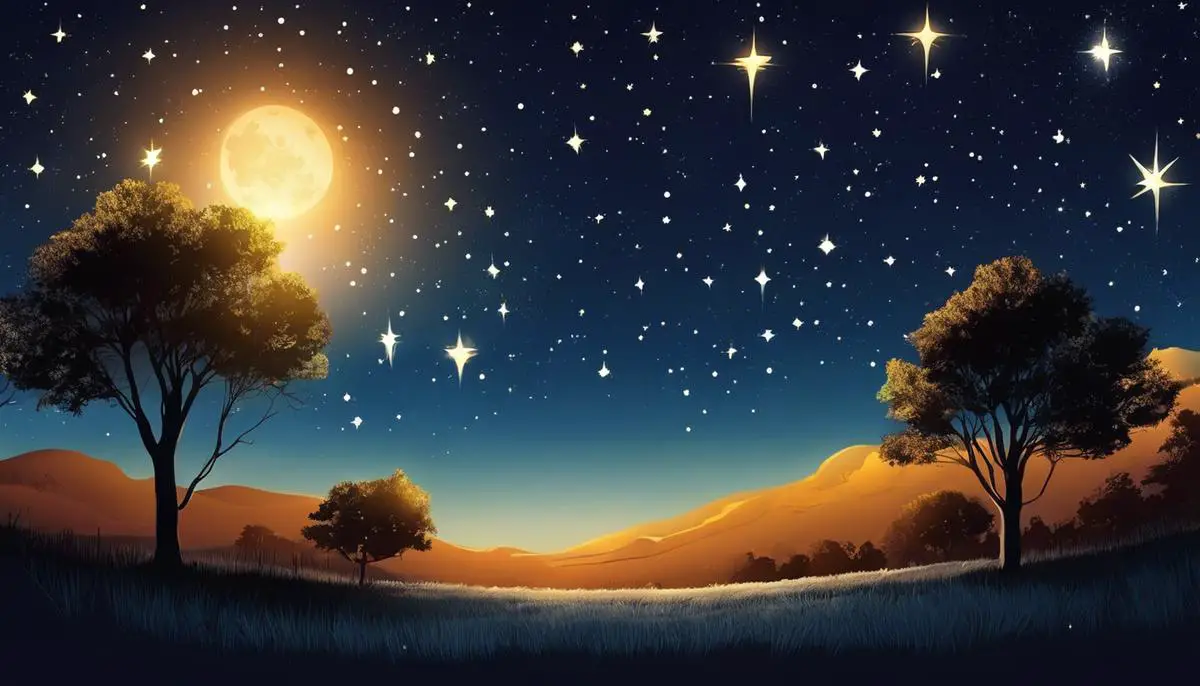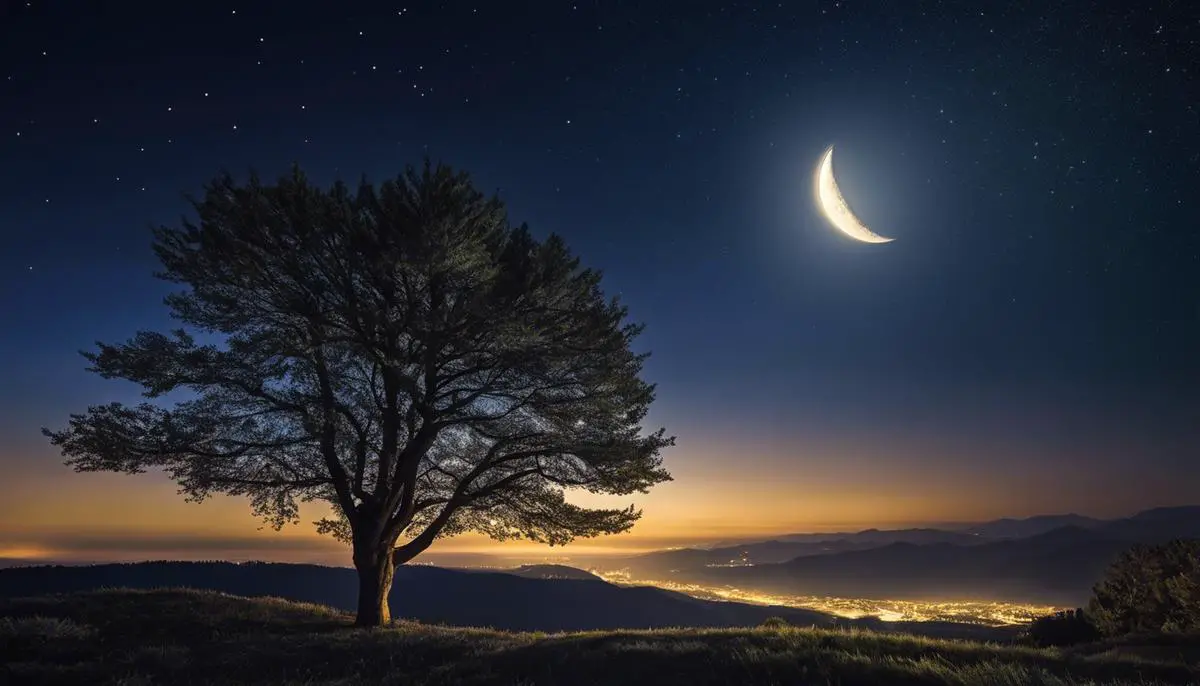As we gaze up at the evening sky, one cannot help but marvel at the vivid celestial bodies that populate the expanse. The moon, in particular, holds a fascination for many, but it isn’t the only object of interest. There is a bright star that often appears near the moon, which lends an even more enchanting beauty to the night sky. This star, its uniqueness, and the reasons behind its perceived proximity to the moon, forms the core of our discussion. We will delve into understanding the intricate science that underlies this entire phenomenon, investigate how light and atmospheric factors alter the vision that meets our naked eye, and explore the cultural and historical significance that humans over time have associated with this captivating theme.
The Star’s Astronomical Position
Reflecting on the vast expanse of the cosmos, an observer may have been captured by the enthralling sight of a bright star twinkling near the moon in the evening sky. This spectacle, notable for its radiant exquisiteness, is not merely random arrangement but the manifestation of an astral phenomenon. The identity of this star, magnificently lighting up the post-sunset horizon, is likely to be the exquisite and resplendent Venus, the celestial body labeled as the evening star.
In the realm of astronomy, Venus, the second planet from the sun, is renowned for its brilliant shine in the night sky, as well as its eminence as the third brightest object in Earth’s sky after the sun and moon. While the term ‘star’ is used colloquially, Venus is indeed a planet prosperous in various atmospheric and geological features.
The elevated brightness of Venus is primarily attributed to its relative closeness to Earth, in addition to a thick and reflective atmosphere predominantly composed of carbon dioxide, which efficiently reflects sunlight. However, its position in reference to the Earth and Sun specifically designates it as the ‘Evening Star’ during some parts of the year.
Venus sequences between ‘Evening Star’ and ‘Morning Star’ roles based on its orientation in the solar system. When it is located on the other side of the Sun, it rises before the sunrise, earning the title of ‘Morning Star’. On the contrary, when it is on the same side of the Sun as Earth, it sets after the Sun and therefore dubbed as ‘Evening Star.’
A rather discernable pattern emerges upon scrutinizing the planetary arrangement. For a significant period, Venus is visible after sunset to the western horizon, performing its role as the ‘Evening Star’. Following its disappearance in the twilight, it remerges before sunrise in the eastern sky as the ‘Morning Star’.
This cyclical astronomical ballet is a consequence of Venus’ interior orbit relative to Earth. The orbital characteristics of Venus, combined with its reflective atmosphere, results in its luminous visibility resembling a resplendent star right next to the moon.
The adroit observation and understanding of this phenomenon elucidates fundamental cosmic mechanics, reinforcing the imperative dialogue between humans and the cosmos. These glimmers in the sky are not mere specks of light, but resounding echoes of a grand cosmic tale whispered in the quiet, but fervent, voices of celestial luminaries.

Understanding the Moon-Star Proximity
The astronomical phenomenon of a star seemingly tethered to the moon is essentially a spatial illusion: a captivating cosmic deception on a celestial scale. The perceived proximity of a star to our lunar neighbor is primarily due to the vast distances involved in space and the limitations of human visual perception. Stars appear close to the moon in our night sky due to a phenomenon called ‘parallax,’ a displacement in the apparent position of a celestial body, when observed from two different points of view. This phenomenon becomes particularly noticeable when the observer’s viewpoint is shifting, as is the case with Earth’s rotation.
Contrary to popular perception, stars and planets are not randomly strewn in the heavens; they are arrayed across an imaginary plane known as the ecliptic. The ecliptic is essentially the apparent path of the Sun against the backdrop of the distant stars as observed from our terrestrial vantage point. Notably, the Moon and planets all precessionally sway very close to this plane, under the orchestrating impulse of gravitational dynamics.
As such, during its monthly journey around our planet, the Moon will pass near many of the more ‘fixed’ celestial bodies, including the seemingly adjacent ‘star’ which is the planet Venus. This apparent conjunction – or apparent proximity in our sky, of the two bodies, can offer spectacularly beautiful scenes.
As part of this grand planetary choreography, the Earth orbits the sun at a faster pace than Venus. This orbital discrepancy results in us overtaking Venus periodically. From our perspective, Venus appears to move back and forth across the sky, which is why Venus is alternately seen as the Morning and Evening Star, tracking closely to the direction of the sun.
Thus, the intricate dance of celestial bodies and our planet’s continual motion create the mesmerizing illusion of a star tethered close to the moon. The acuteness of celestial mechanics, our eyes’ technical constrictions, and the enormity of spatial distances are all interwoven into this beguiling cosmic spectacle. Highlighting just how much there remains to observe, understand, and relish, in the grand theater of our solar system.

Effects of Atmospheric & Light Phenomena
The perception of the evening sky is affected by a multitude of complex interactions and phenomenal occurrences. An understanding of these dynamics enriches our appreciation of celestial beauty and reinforces its intrinsic scientific value.
Perhaps, the most intriguing factor affecting our perception of the evening sky is the role of atmospheric refraction. This phenomenon occurs when light from celestial bodies passes through Earth’s atmosphere, causing their apparent position to shift. Atmospheric refraction is greater near the horizon as the light from celestial bodies pass through a thicker layer of atmosphere. Consequently, when we see the moon low in the sky, atmospheric refraction can give it a slightly flattened appearance.
In addition to this, atmospheric conditions and the presence of certain particles contribute significantly to the variation in colors seen in the evening sky. Molecules and tiny particles in Earth’s atmosphere scatter short-wavelength light, such as blue and violet light, to the far corners of the sky. This scattering results in the vibrant hues of orange and red that often hallmark our evenings.
Just as Venus a crucial element in our evening spectacle, other planets too make their appearance in our night sky. Mars, for instance distinguishable by its reddish hue, visible to the naked eye as well as Jupiter, the largest planet of our Solar System, periodically visible at night. The visibility of these celestial bodies significantly rests upon their relative position and alignment in their orbital paths.
Of particular interest is the phenomenon of “twilight”, the period post sunset, where the sky is not completely dark. This is due to Earth’s atmosphere scattering sunlight in all directions, even when the sun dips below the horizon. The three established stages of twilight are civil, nautical, and astronomical – varying degrees of illumination caused by how far below the horizon the center of the sun is. This plays a crucial role in dictating the visibility of celestial objects in the night sky.
Furthermore, our perception of the evening sky is also governed by our location on Earth. People dwelling in different hemispheres, or at different latitudes, will not view the sky in the same way due to the curvature of Earth and resultant angle of vision. For example, observers in the Southern Hemisphere have a unique view of the center of our galaxy, the Milky Way.
Thus, understanding the evening sky and its myriad of celestial displays requires a deep knowledge of a multitude of phenomena. To peel back the layers of the night sky, one must partake in a journey through the depths of atmospheric science, light phenomena, and celestial mechanics. Despite complexity and continual changes, the evening sky remains one of the most captivating and inspiring theaters of scientific exploration, offering an open window into the wonders of our universe.

Historical and Cultural Importance
The role of celestial bodies, particularly bright stars, in human culture and history cannot be overstated. For millennia, these shimmering beacons in the firmament have served as nautical markers, harbingers of seasonal shifts, spiritual symbols, and subjects of scientific scrutiny.
One such bright star that has been etched in the tapestry of human history and mythos is Venus, our closest planetary neighbor and conspicuous evening presence. Awe-inspiring as it is, the appearance of this celestial beacon has been subjected to diverse interpretations across different civilizations, largely due to its diurnal manifestation as the ‘Evening Star’ and the ‘Morning Star.’ But beyond its physical and cyclical properties, this star’s appearance carries immense cultural and historical significance.
In Babylonian astronomy, Venus was identified with the goddess Ishtar, embodying love and war. The duality of these qualities is reflective of the planet’s astronomical behavior, seen either as a radiant beacon in the twilight or a herald of dawn, representing both the calm and the tumult. The Sumerians and the Akkadians also recognized Venus’ dual manifestation in the sky, annotating it in their clay tablets as the star of Inanna, the Queen of Heaven.
In Ancient Greek cosmology, Venus was seen as not one, but two stars: Hesperus, the Evening Star, and Phosphorus, the Morning Star. This belief was retained until Hellenistic astronomy unraveled the truth that these two separate stars were indeed one — Venus, leading to the recognition of its cyclical behavior in the sky.
Venus’ splendid visibility also left its mark in the civilization of Maya. They tracked Venus’ synodic period with commendable accuracy, recording its astronomical movements and translating them into their unique calendar system, the Venus Table. The various phases and motions of Venus played a pivotal role in Maya rituals and agriculture decisions, illustrating its extensive influence on human societal practices.
In New Zealand, the Maori recognized the ‘Evening Star’ as Meremere-tu-ahiahi, while the ‘Morning Star’ was known as Tawera. Meremere-tu-ahiahi’s presence signaled the change in the wind direction, serving as a guide for their navigation and fishing periods, thereby exhibiting the functional significance of Venus in the survival and cultural practices of our ancestors.
In more recent history, Galileo Galilei’s observation of Venus went on to shake the foundations of the prevailing geocentric model of the universe. By observing the planet’s distinct phases through his primitive telescope, much like our moon’s phases, he presented evidence supporting the heliocentric model, where the Earth and planets orbit the sun, fundamentally altering the trajectory of astronomy and science.
In conclusion, the radiant appearance of Venus in the evening sky resonates far beyond its astronomical significance. The historical and cultural context of its perception sheds light on the intricate bond between human societies and the celestial realm. This brightly twinkling ‘star’ in our evening sky carries stories of our ancient ancestors’ understanding of the universe, the evolution of our scientific knowledge, and enduring cultural narratives and practices, making its recurrent evening dance a profound symphony of human history and cosmic wonder.

A celestial event such as the appearance of a bright star near the moon captures our imagination and drives our curiosity to understand the wonders of the universe. As we have observed, understanding its scientific reasoning requires a deep dive into complex concepts like celestial mechanics, angular separations, and earth’s rotation. However, beyond the science, there is also a rich tapestry of cultural and historical interpretations that make this a captivating subject. The historical context provides insight into how human narrative and worldviews are shaped by the cosmos. It’s a reminder that space is not just about cold, hard science, but is also intrinsically woven into our human history, our mythology, and our collective consciousness.
![]()
